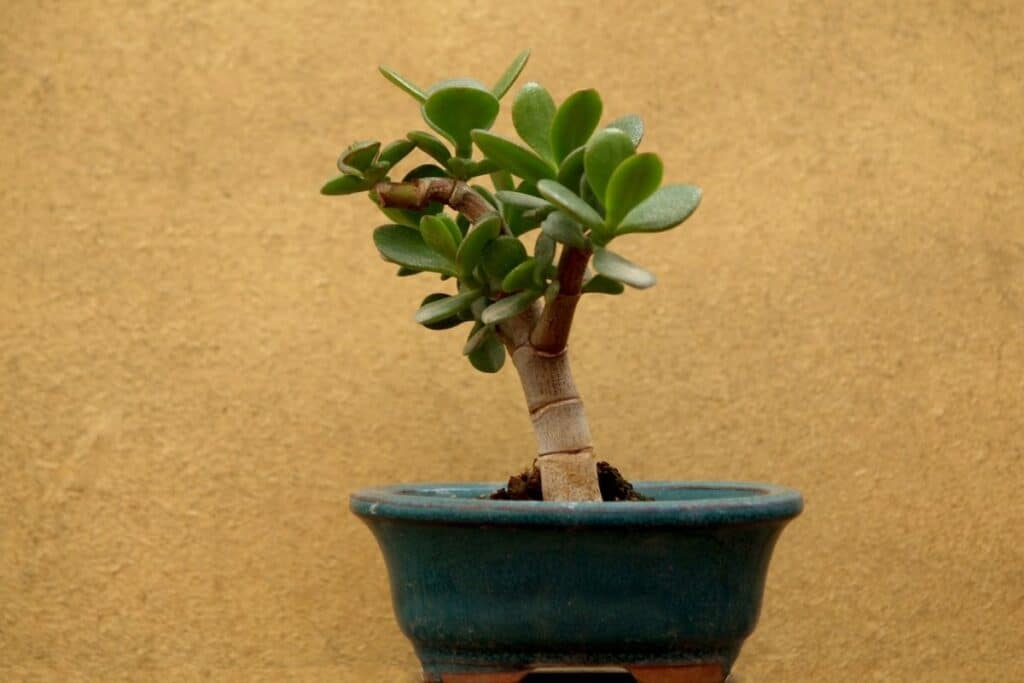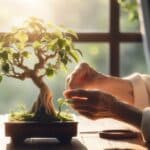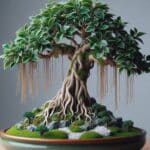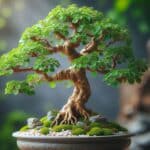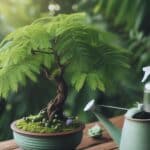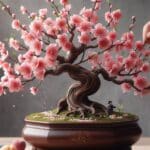With a thick trunk and a uniquely contrasting fine branch structure, the jade bonsai tree is a specimen worth considering for your collection.
It offers lots of interest for hobby bonsai growers. From its occasional white flowers in autumn to its thick green succulent leaves, Dawrf Jade is a beautiful plant that’s also easy to care for in a bonsai fashion.
Jade, or Crassula ovata, only grows up to 10 feet tall when allowed to grow to full size. When grown in a bonsai style, it will be even smaller, possessing soft green bark and lovely star-shaped white blooms with pink tips (but only when grown outdoors – it does not bloom when you grow it inside).
Interesting Facts about Jade Bonsai Tree
| Height | 4-10” |
| Width | 8” |
| Sunlight | Full sunlight |
| Flowering Time Length | 3-5 weeks |
| Lifespan | 100+ years |
| Scientific Name | Crassula ovata |
Growing Jade Bonsai Tree from Seed or by Propagation
Jade is easy to grow from cuttings, though it can also be done from seed. The best time to plant a dwarf jade cutting is during the summer months, though it can technically be done year round as well.
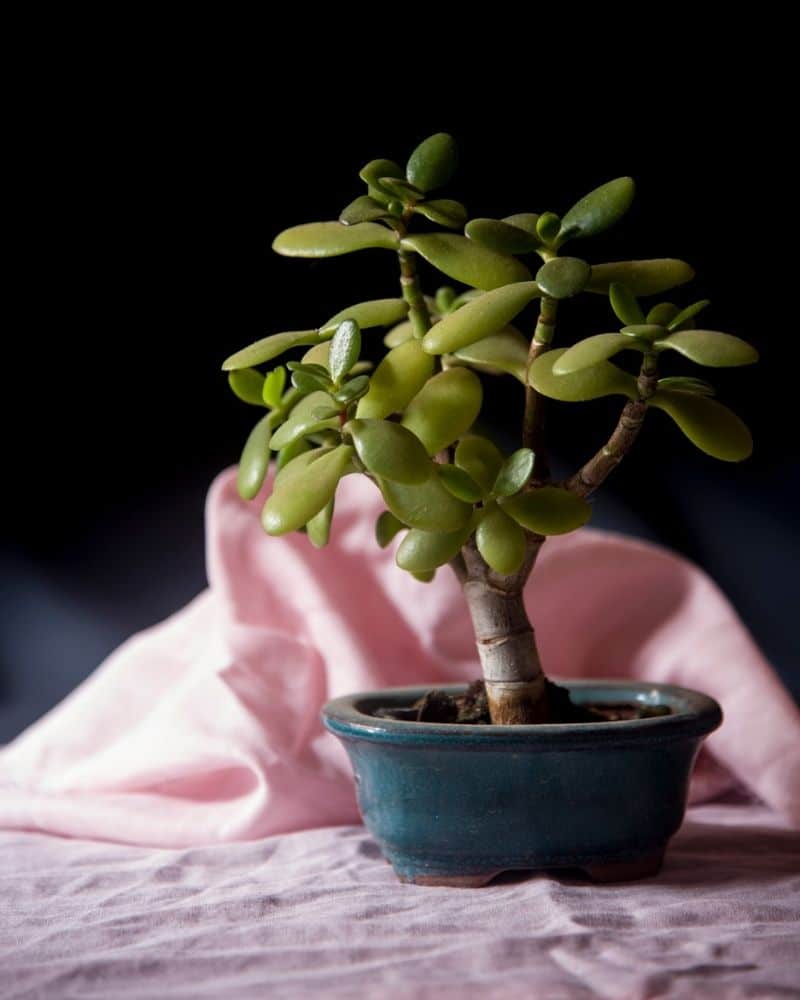
How to Care for Jade Bonsai Plant
Captivated by your miniature jade bonsai but unsure how to keep it thriving? Dive into this comprehensive guide for essential bonsai tree care secrets, unlocking the art of cultivating a healthy and stunning miniature masterpiece.
Sunlight
The best place to position your jade plants will be in a full sun location. However, it is a unique succulent in that it can occasionally handle a bit of shade as well. These plants should be kept warm during the day, around 70-75 degrees, and a bit cooler at night (around 50-55 degrees).
Not too cool though – this Jade tree won’t survive when the temperature dips below 40 degrees Fahrenheit, so if you plan on growing it outdoors, make sure your outdoor climate is suitable.
Watering
Jade, as a succulent, can hold a large amount of water in its leaves. Therefore, this unique bonsai tree is more likely to be overrated than it is to be underwatered. When you’re keeping the plant cool during the winter months, you may find that you only need to water once every three to four weeks.
Simply water when the soil is dry to the touch. Although it is not as sensitive to overwatering as other kinds of succulents, you do still need to be careful about leaving its roots in water.
Fertilizing
Jade bonsai trees should be fertilized once per month during the growing season. You do not need to fertilize during the winter. Just use a standard, balanced fertilizer – there’s nothing special you need to do.
Potting and Repotting
You should only need to repot your jade bonsai about once every two years – the best time to do this is in the spring. When you repot, use a well-draining soil mixture and avoid watering for a week or so after you have reported your plant. This will let any injuries to the roots or bark heal before water gets in, which can cause rot.
You can read our guide about jade plant soil for more details.
Pruning Jade Bonsai Tree
Jade bonsai holds water in its branches and trunk. Because of this, the limbs are naturally heavy and pliable, meaning they respond quite well to pruning. You can prune it to grow new branches on the lower areas of the trunk. Just make sure you don’t use cut paste when you trim – jade’s soft bark makes it more susceptible to rot.
Pests and Diseases
As long as you water and fertilize your crassula ovata bonsai appropriately (and make sure it’s positioned in a full sun location), you shouldn’t have any issues with diseases and pests.
Occasionally, you may find that mealy bugs, root rot, or aphids become problematic. Mealy bugs, spider mites, and aphids can harm jade plants and promote fungal growth. These can be treated with insecticides – although root rot, as a fungal disease, has no cure. It’s easier to prevent this disease by avoiding overwatering.
A good way to make sure your bonsai tree receives the water it needs without overwatering is to simply mist it. This will allow the leaves to remain green and healthy, increasing humidity without allowing the plant to become waterlogged.
Where to Buy Jade Bonsai Tree
You can purchase jade trees for bonsai growing from any tree nursery. However, you may be better off purchasing a jade plant from a specialty bonsai dealer, as this will ensure a healthier plant overall.
FAQs
How much light does a jade bonsai tree need?
Jade bonsai trees (Crassula ovata) thrive in bright, indirect light. Providing them with a few hours of morning sunlight or filtered light throughout the day is ideal for their growth and well-being.
How do I make my jade bonsai trunk thicker?
To encourage a thicker trunk on your jade bonsai, let the plant grow freely without pruning for a period. Additionally, expose it to ample sunlight, as this promotes robust growth, leading to a thicker trunk over time.
Can you plant a jade plant in bonsai soil?
While it is possible to plant a jade plant in bonsai soil, it is generally not recommended. Jade plants, being succulents, thrive in well-draining soil with a higher proportion of materials like perlite or coarse sand to prevent waterlogging and ensure optimal growth.
Is the Crassula Ovata tree an indoor bonsai?
Yes, the Crassula ovata, commonly known as the jade plant, is well-suited for indoor bonsai cultivation. Its adaptability to indoor conditions and preference for bright, indirect light make it an excellent choice for bonsai enthusiasts who primarily keep their plants indoors.
See more: Portulacaria Afra Dwarf Jade Bonsai
*images by eskaparate/depositphotos

